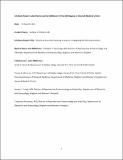| dc.description.abstract | Purpose: Cancer treatments have significant negative impacts on female fertility. The impact of cancer itself on female fertility is unclear. The purpose of this study was to evaluate the effect of malignancy on ovarian stimulation during egg and embryo banking.
Methods: Data was prospectively collected from 13,221 consecutive ovarian stimulation cycles at a single, academic medical center between June 2007 and October 2014. One-hundred-forty-seven women underwent assisted reproduction to cryopreserve oocytes and/or embryos for the purposes of fertility preservation after a cancer diagnosis. Of these, 105 women were diagnosed with local cancer (Stage I-III solid malignancies) and 42 carried diagnoses of systemic cancer (Stage IV solid malignancies or hematologic malignancies). These women were compared to 664 healthy women undergoing their first ovarian stimulation cycle for in vitro fertilization due to male factor infertility, with no evidence of female causes of infertility. Multivariable linear, Poisson, and logistic regressions were applied to calculate β-coefficients, relative rates, and odds ratios, respectively, and 2-sided Wald p-values (p).
Results: Adjusting for age and BMI, women with systemic cancer had lower baseline antral follicle counts than women with no cancer or local cancer [relative risk (95% CI): 0.58 (0.41, 0.83) and 0.64 (0.42, 0.97)]. Women with systemic cancer required higher doses of gonadotropins than women with no cancer [2483.0 (2050.8, 2915.2)] or local cancer [1124.82 (380.5, 1869.2)]. Women with systemic cancer had greater odds of cycle cancellation as compared to women with no cancer or local cancer [odds ratio (95% CI): 14.41 (4.83, 42.98) and 17.03 (2.94, 98.71)]. No significant differences were observed regarding duration of stimulation, number of oocytes and mature oocytes retrieved, or number of embryos created. Fifteen women returned to use frozen embryos; 18 transfers resulted in 8 live births (44% live birth rate per cycle). One patient returned to use frozen oocytes, but did not achieve pregnancy.
Conclusions: Women with cancer achieve similar oocyte and embryo yields as women with no cancer, although they require higher FSH doses and are at greater risk of cycle cancellation. | |


